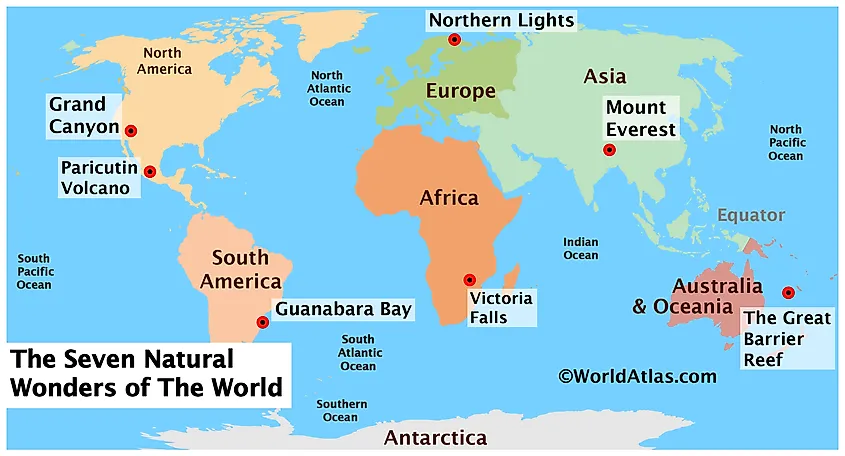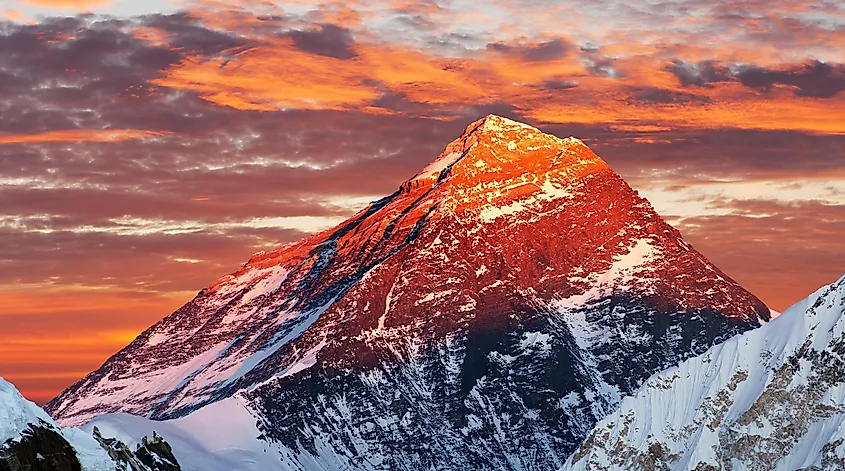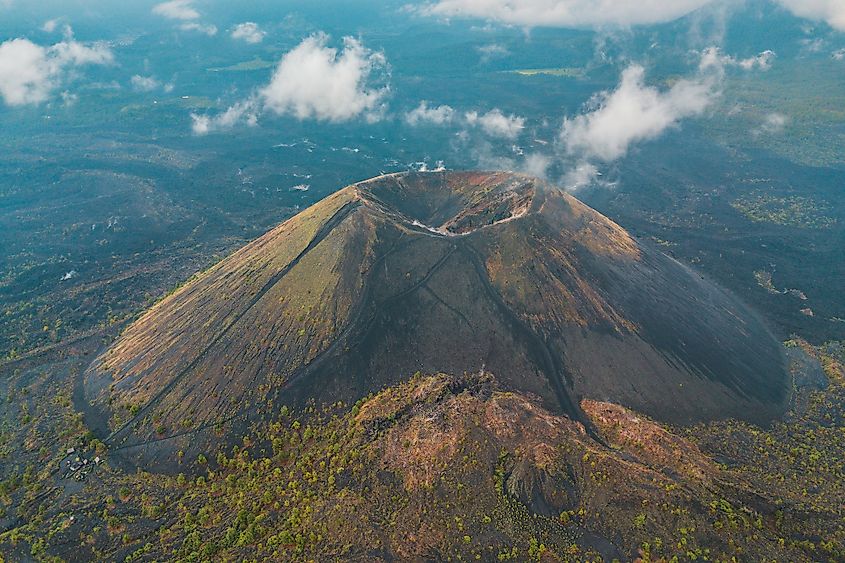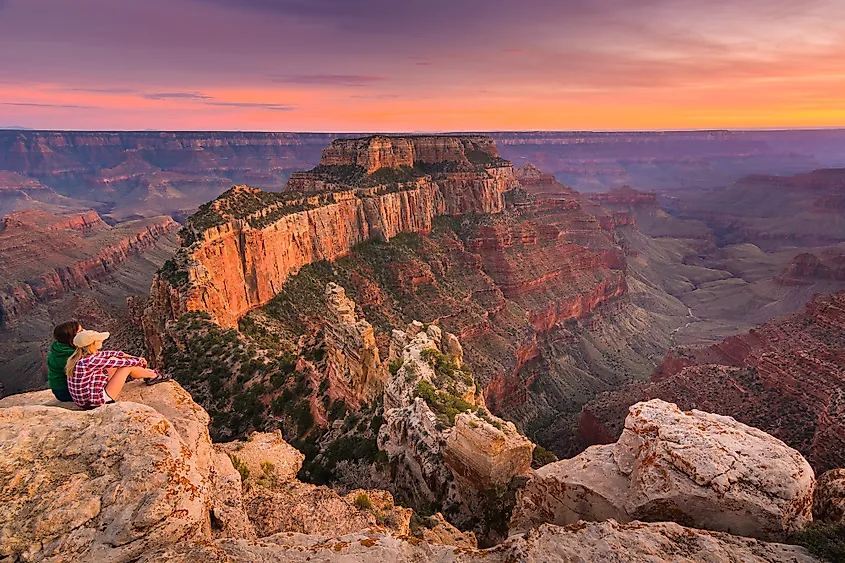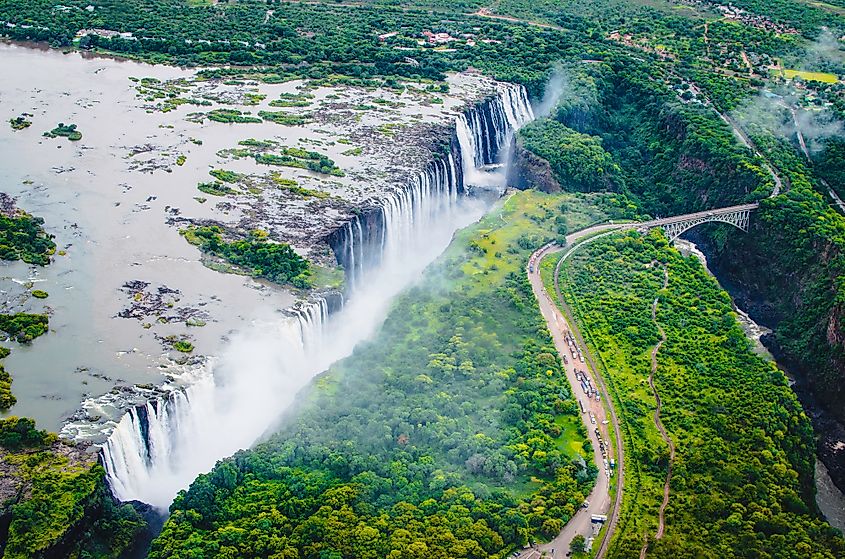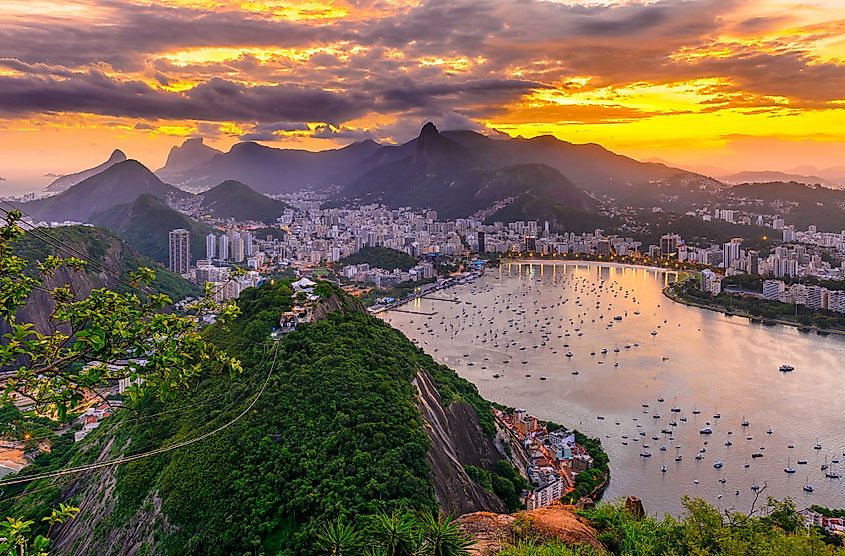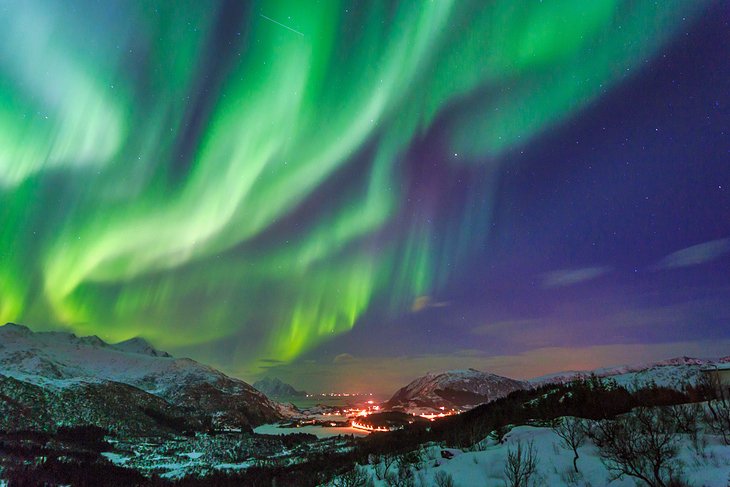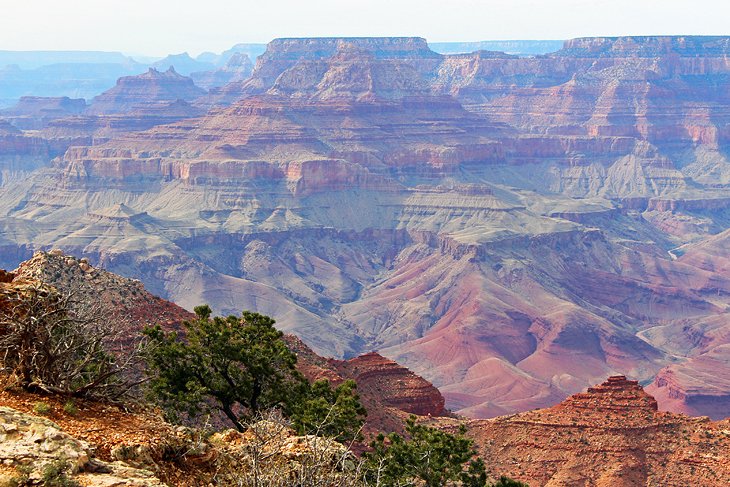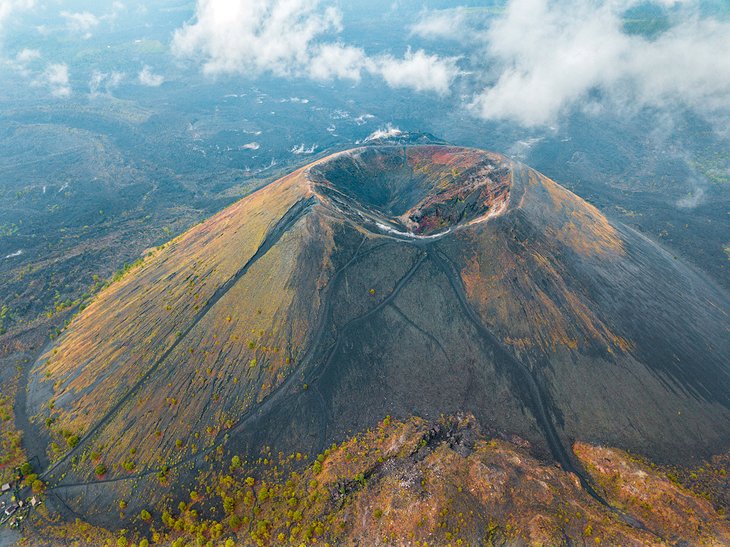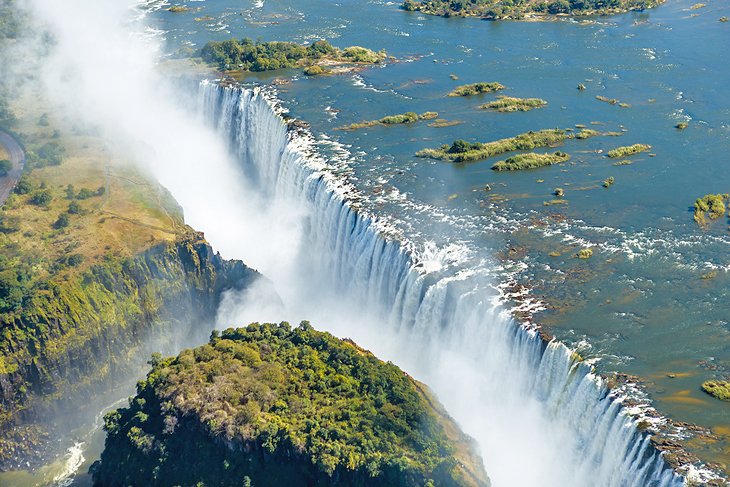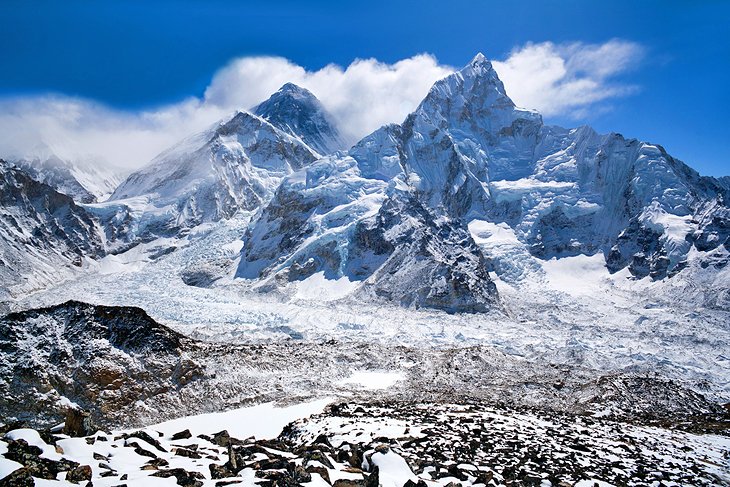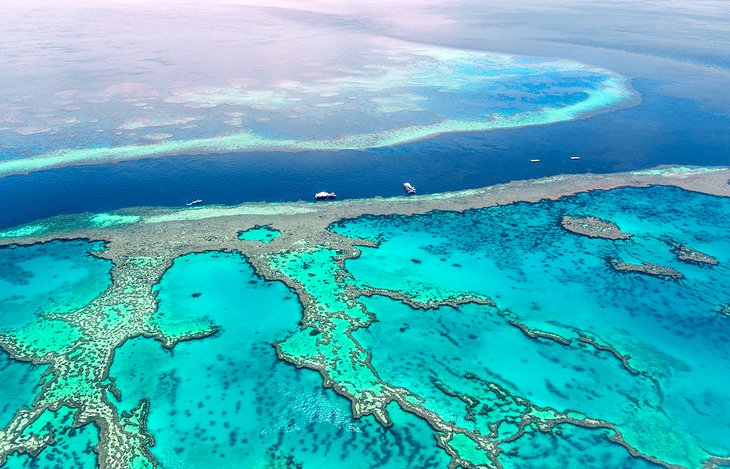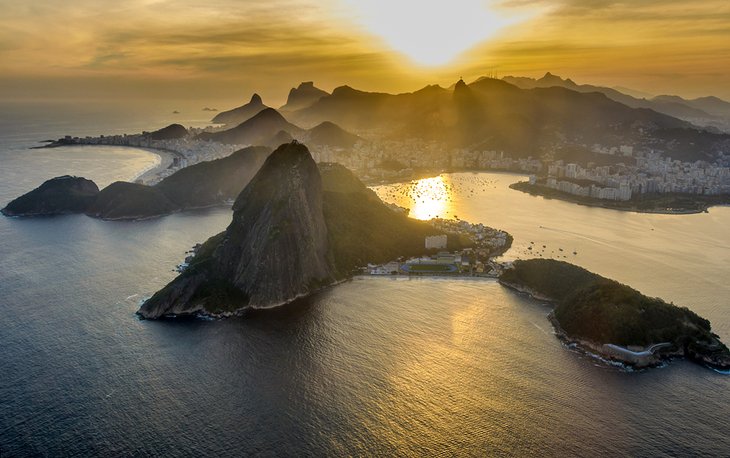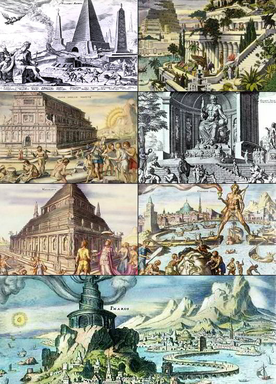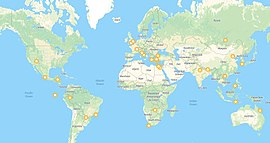When thinking of the wonders of the world, the Great Pyramids or the Colosseum may spring into mind. While unmistakably incredulous, the list below describes the wonders that Mother Nature created at her own will to enchant and put humans in awe at the mere sight of these wonders. From mountain peaks to waterfalls, underwater marvels, and dazzling sky optics, each natural wonder highlights a different aspect of the beauty of Earth’s natural world.
The 7 Natural Wonders Of The World
The official list of the 7 Natural Wonders was compiled by CNN, the broadcasting network in collaboration with the Seven Natural Wonders organization.
- Mount Everest
- Paricutin Volcano
- The Grand Canyon
- Victoria Falls
- The Harbor Of Rio de Janeiro
- Great Barrier Reef
- Northern Lights
Mount Everest
When thinking of some of the most impressive natural landscapes in the world, it is impossible not to think of Mount Everest. Mount Everest is known as the tallest peak on Earth and measures 8,848.86 meters tall. Generally, people think of it as the tallest mountain in the world, but that isn’t quite accurate. Mauna Kea, in Hawaii, is actually a taller mountain, but much of it is underwater, and thus it does not have the tallest peak ‘above sea level.’ This is why Everest is generally considered to be the overall tallest, as it is much easier to see and comprehend the sheer size of the mountain and its summit.
Mount Everest is part of the Himalayan mountain range and is located along China(Tibetan)-Nepal border. The official borderline actually runs across the summit of the mountain, meaning it technically belongs to both countries. The English name, Everest, is named after George Everest, who was a surveyor of India. The Nepali term for the mountain peak is Sagarmatha, and in Tibet, it is known as Chomolungma, which roughly translates to “Mother Goddess of the World.”
Paricutin Volcano
Another one of the natural wonders of the world is Parícutin. It is a cinder cone volcano that can be found in Michoacán, Mexico. The cone has only really existed as it is since 1943, when it surged up out of the ground in a relatively flat cornfield, making it the youngest volcano in the Northern Hemisphere. At the time that it surged, it also erupted and continued to erupt over a period of 9 years. Now, the volcano is considered to be dormant and is popular as a tourist attraction. Visitors are able to climb the volcanic peak and view the hardened lava flows, including encased ruins of the San Juan Parangaricutiro Church.
The Grand Canyon
The Grand Canyon is a striking canyon located in Arizona, United States. The canyon was formed by the natural erosion of rock and soil by the Colorado River, over a period of billions of years. The canyon is stunning not only for its deep rust-red colors, and the visible layers of rock and sediment that can be seen throughout its cliff walls but mainly it is impressive for its size and depth.
The Grand Canyon is aptly named, as it measures some 446 kilometers in length, up to 29 kilometers wide at its widest point, and a whopping 1.8 kilometers deep. The magnitude of the canyon is awe-inspiring, but the age is also astounding, as the phenomenon reveals millions of years of geological history. Many visitors choose simply to gaze at the sight, but it is also possible to hike along the top of the canyon cliff, in the ravine, or raft and boat in the river below.
Victoria Falls
Victoria Falls is one of the seven natural wonders of the world because it is considered the largest waterfall in the world. It is important to note that it is ‘largest’, as these falls are not the tallest nor are they the widest falls on the earth, however, their combined height and width (1,708 meters wide by 108 meters in height) make them larger than any other set of falls — they have the largest sheet of falling water of anywhere on Earth (especially during the wet rainy season).
The falls are located along the border between Zambia and Zimbabwe, in southern Africa, and are formed by the Zambezi River. Tourists come from all over the world to see the spectacular natural wonder and witness the 500 million liters of water which cascade over the cliff edge every minute. Visitors can view the falls from vantage points, or more adventurous travelers can swim in the river right up to the fall’s edge (in low season) and even bungee jump from the Victoria Falls Bridge.
The Harbor Of Rio de Janeiro
The Harbor of Rio de Janeiro can be found in the southeast of Brazil. Also known as Guanabara Bay, it is the world’s largest natural bay, based on volume, and that is why it is classified as one of the seven Natural Wonders of the world. The bay is a huge expanse of water, which is surrounded by granite rock formations and monoliths which add to the striking visual appeal of the area.
Though the harbor has also become a massive hub of human activity, from the city of Rio to public beaches such as Copacabana and an active harbor, the natural beauty of the bay remains, and it is clear to any visitors that the region is a true natural beauty.
Great Barrier Reef
The Great Barrier Reef is the largest coral reef system in the world. It is made up of 2,900 smaller reef sections and 900 islands which together make up some 2,300 kilometers of reef across 344,400 square kilometers of ocean. These reefs, or reef system, is located in the fittingly named Coral Sea, which is off the coast of Queensland, Australia.
The reef contains a huge variety of coral, fish and marine species, from plantlife and tiny aquatic organisms to sharks, turtles, and rays. This region has historically been one of the most biologically diverse areas, and the array of colors and life that can be found here is remarkable.
Visitors and tourists come from all over the world to marvel at the reefs and the sea life that lives among them, diving and snorkeling amongst the forests of coral and reef. Though tourism and climate change have had negative effects on the reef, conservation efforts hope to protect this beautiful and delicate habitat to ensure the world does not lose this amazing natural wonder.
Northern Lights
Just as there is a natural wonder below sea level there is also one above it, in the sky. The Northern lights, more scientifically called the Aurora Borealis, is a natural phenomenon that marks the seventh natural wonder of the world. The Aurora appears as a light show of beautiful dancing colors — usually greens blue and purples — when electrically charged particles caused by sun flares or extreme sun activity reach the gaseous particles found in the Earth’s atmosphere. The result is a moving and awe-striking rainbow of moving color that has to be seen to be truly taken in. This is a natural wonder as it is a striking example of how a naturally occurring phenomenon — such as a sun flare — can result in a beautiful event on Earth.
Generally, the northern lights can be seen more clearly and frequently closer to the Arctic Circle. Polar regions have some of the most phenomenal displays, especially as light pollution from cities is virtually nonexistent there. However, the aurora can be seen in several countries including the US state of Alaska, large sections of northern Canada, as well as Iceland, Greenland, Norway, Sweden, and Finland.
Each of the seven wonders offers a different look at a natural phenomenon that has occurred or continues to occur on Earth. By reflecting on these wonders, we can help to appreciate the beauty around us, as well as marvel at the stunning natural phenomena around the world.
Other Lists Of Wonders
The Seven Wonders of the World is an official list of the most spectacular places around the world
The Seven Wonders of the Ancient World include picks from ancient times, such as the Lighthouse of Alexandria, the Temple of Artemis, the Statue of Zeus of Olympia, the Colossus of Rhodes, and the Hanging Gardens of Babylon.
The 10 Wonders of the Medieval World include the most impressive wonders of the Middle Ages. Examples of these wonders include Stonehenge, the Hagia Sophia, and the Leaning Tower of Pisa.
The Earth offers spectacular natural wonders that only a small percentage of people will ever see in their lifetime. A global popularity poll announced seven provisional winners that outrank other splendid sights. These 7 natural wonders of the world include the Northern Lights, the Grand Canyon, Paricutin, Mount Everest, Harbor of Rio de Janeiro, Victoria Falls, and the Great Barrier Reef.
Many of these naturally-formed displays require an aerial view to capture the vastness of each phenomenon. Avid explorers, daredevils, backpackers, expatriates, and tourists should place these 7 natural wonders on their bucket lists of destinations to visit.
1. The Northern Lights: Aurora Borealis
The Northern Lights have become a sensation for tourists traveling in the Northern Hemisphere. The Northern Lights are auroras, or naturally occurring phenomena that consist of mystifying displays of light in the sky. The northern lights dance across the sky and emanate a diffused glow along the northern horizon.
The intensity of northern lights increases as you head north towards the magnetic pole in the Arctic. Unfortunately, the northern lights appear only randomly, making it a challenge for travelers to see while on a short trip. They are more often experienced by locals who live in these northern regions.
Planning a trip to the see the northern lights presents a variety of options for interesting destinations around the world. The best places to see the northern lights are in the far part of the Northern Hemisphere, including Canada’s far north, Alaska, Iceland, Norway, Sweden, and Finland.
The probability of seeing Northern Lights increases during the winter months. They occur throughout the year but the dark skies in winter make them easier to see.
Read More:
- The Aurora Page
- Aurora Forecast
2. The Grand Canyon
You only need to stand on the rim of the Grand Canyon once to know why it’s one of the 7 natural wonders of the natural world. The Grand Canyon’s massive and colorful landscape provides breathtaking views that can’t be found anywhere else in the world.
Most visitors head to the South Rim of the Grand Canyon and spend a full day admiring the views from the overlooks that stretch along the top of the canyon. If you are in good shape and want to have a more immersive experience, head down into the canyon on one of the numerous hiking trails. For something a little less strenuous, take a helicopter tour of the Grand Canyon for an unforgettable lifetime experience.
If you are interested in the formation and geology of the canyon, stop in at the Geological Museum to learn about what you are seeing. From Lipan Point along Desert View Drive, you can get a great view of the rock layers in the canyon wall.
The Grand Canyon is located in Arizona, USA. The closest major cities are Las Vegas and Phoenix.
Read More:
- Top-Attractions & Things to Do at the Grand Canyon
- Best Time to Visit the Grand Canyon, AZ
3. Paricutin
Even avid travelers may not know about Paricutin, mainly because this natural wonder resides in Michoacán, Mexico. This cinder cone volcano was named one of the 7 natural wonders of the world, even over famous volcanoes, such as Yellowstone.
Paricutin last erupted in 1952. It was coined one of the natural wonders of the world because mankind witnessed its birth and rapidly growing formation. You can venture on a twelve-mile round-trip to the peak of the volcano, either by hiking or horseback. Hikers will walk through sandy banks and lava fields surrounding the volcano.
You can explore Paricutin at any time of the year. It’s located about a seven-hour drive from Mexico City. Combine a trip to the volcano with a visit to the capital city for a bit of nature and culture all in one. Accommodation near the volcano can be found in the city of Urapan.
Read More: The Eruption of Paricutin
4. Victoria Falls
Victoria Falls is located in Africa along the borders of Zambia and Zimbabwe. This spectacular waterfall runs off from the Zambezi River.
Visitors can access the falls from Victoria Falls in Zimbabwe and Livingston in Zambia. Cross the border to gain different perspectives of this magnificent natural wonder. The best views are from Zimbabwe, but you can get a closer experience from Zambia. Helicopter tours and microlight tours are another great way to see the falls. If you are brave, consider a swim in the Devil’s Pool, located pretty much at the edge of the falls on the Zambia side
The rainy season runs from late November through early April. A good time to visit is immediately after this, when the volume of water coming over the falls is still immense, but the weather is pleasant.
Getting to Victoria Falls is easy whether you choose to fly into Zambia or Zimbabwe. The airport in Zambia, Harry Mwanga Nkumbula International Airport (LVI), is closer and the more popular of the two. Most people fly into Johannesburg and then fly out from there to the falls. Be sure to keep an eye on your baggage weight, as the smaller planes flying into these airports have lower limits.
5. Mount Everest
Mount Everest has an approximate elevation of 29,029 feet. Mountaineers consider this mountain the highest spot on Earth; however, it is not the tallest mountain in the world, a title that belongs to Mauna Kea in Hawaii. Everest lies within the Himalayan mountain range on the border of Nepal and Tibet, China.
If you don’t want to climb Mt. Everest, you still have options. Visitors can schedule a flight around the mountain for an awe-inspiring aerial view. Adventurous trekkers can hike to base camp to fully experience Mount Everest’s landscape. Alternatively, you can capture a distant view of the peak from the comfort of a lodge at a hill station in Nepal.
Read More: Top-Rated Tourist Attractions in Nepal
6. Great Barrier Reef
As the world’s largest coral reef, the Great Barrier Reef includes over 900 islands, roughly 3,000 separate reefs, and sustains a diverse ecosystem. Measuring approximately 2,300 kilometers in length, it covers an immense area of the ocean, much of it a long way offshore.
Boat trips and excursions offer visitors a chance to experience the highlights of the Great Barrier Reef. Snorkeling or dive trips can be arranged, and provide opportunities to see colorful fish, coral, and marine life. Tours can be day trips or multi-day excursions. Popular destinations from which to explore the reef include Cairns, Port Douglas, and the Whitsunday Islands.
7. Harbor of Rio de Janeiro
The Harbor of Rio de Janeiro is surrounded by granite mountains and pinnacles covered in greenery. Iconic sights surrounding the harbor include Sugar Loaf Mountain, Corcovado Peak, and the Tijuca hills.
The traditional way of seeing this natural wonder is to travel via the rack railway to Tijuca National Park. This takes you to the uppermost region, where the statue of Christo Redentor stands atop one of the granite peaks that overlooks the harbor. From the viewing platforms, soak up the spectacular views of the beautiful beaches below you and the mountains in the distance.
For a jaw-dropping experience, explore the Harbor of Rio de Janeiro on a helicopter flight to capture a breathtaking aerial view.
- Read More: Things to See and Do in Rio de Janeiro
More Wonders of the World
The above list covers only natural wonders. A number of compiled lists exist from classical antiquity to the present day that catalog the world’s most amazing wonders, including man-made structures. Some of these ancient sights, many of them lost for various reasons over time, include the Great Pyramid of Giza, Statue of Zeus at Olympia (lost), the Colossus of Rhodes (lost), and the Lighthouse of Alexandria (lost).
Other no less spectacular sights from around the globe include some of the most fantastic World Heritage Sites. A few of the more well-known ones include Angkor Wat in Cambodia, Machu Picchu in Peru, Tikal in Guatemala, and the Taj Mahal in India.
An international non-profit organization named CEDAM International produced the 7 wonders of the underwater world that includes Palau, Lake Baikal, the Northern Red Sea, the Galapagos Islands, and the Deep-Sea Vents. The 7 wonders of the industrial world include the SS Great Eastern, Brooklyn Bridge, Panama Canal, and the Hoover Dam.
If you’re looking for more inspiration to guide your travels, the top tourist attractions in the world may be just the answer.
This article is about natural and man-made phenomena and structures of the world. For other uses of «Wonders of the World», see Wonders of the World (disambiguation).
Various lists of the Wonders of the World have been compiled from antiquity to the present day, in order to catalogue the world’s most spectacular natural features and human-built structures.
Map of places listed in various Wonders of the World lists (interactive map)
The Seven Wonders of the Ancient World is the oldest known list of this type, documenting the most remarkable man-made creations of classical antiquity; it was based on guidebooks popular among Hellenic sightseers and as such only includes works located around the Mediterranean rim and in the ancient Near East. The number seven was chosen because the Greeks believed it represented perfection and plenty, and because it reflected the number of planets known in ancient times (five) plus the Sun and Moon.[1]
Seven Wonders of the Ancient World
The Greek historian Herodotus (484 – c. 425 BC) and the scholar Callimachus of Cyrene (c. 305–240 BC), at the Museum of Alexandria, made early lists of seven wonders. These lists have not survived, however, except as references in other writings.
The classic Seven Wonders were:
- Great Pyramid of Giza, in El Giza, Egypt, the earliest of the wonders to be completed, as well as the only one that still exists in the present day.
- Colossus of Rhodes, in the harbor of the city of Rhodes, on the Greek island of the same name.
- Hanging Gardens of Babylon, in Babylon, near present-day Hillah, Babil province, Iraq; or Nineveh, Mosul, Nineveh Governorate, Iraq.
- Lighthouse of Alexandria, in Alexandria, Egypt.
- Mausoleum at Halicarnassus, in Halicarnassus, a city of the Achaemenid Empire in present-day Turkey.
- Statue of Zeus at Olympia, in Olympia, Greece.
- Temple of Artemis at Ephesus, in the city of Ephesus, near present-day Selçuk, Turkey.
Lists from other eras
In the 19th and early 20th centuries, some writers emulated the classical list by creating their own lists with names such as «Wonders of the Middle Ages», «Seven Wonders of the Middle Ages», «Seven Wonders of the Medieval Mind», and «Architectural Wonders of the Middle Ages».[2] It is unlikely that any of these lists actually originated in the Middle Ages since the concept of a «Middle Age» did not become popular until at least the 16th century and the word «medieval» was not invented until the Enlightenment era. Brewer’s Dictionary of Phrase and Fable refers to them as «later list[s]»,[3] suggesting the lists were created after the Middle Ages.
Many of the structures on these lists were built much earlier than the Middle Ages but were well known throughout the world.[4][5] Typically representative of such lists are:[3][4][6][7]
- Catacombs of Kom el Shoqafa, a 2nd-century funerary complex in Alexandria, Egypt.
- Colosseum, a 1st-century amphitheatre in the centre of the city of Rome, Italy.
- Great Wall of China, a series of defensive fortifications built across the historical northern borders of China, with some segments dating to as early as the 7th century BC.
- Hagia Sophia, a 6th-century cathedral and mosque in Istanbul, Turkey.
- Leaning Tower of Pisa, a 12th-century bell tower in Pisa, Italy.
- Porcelain Tower of Nanjing, a 15th-century pagoda on the south bank of the external Qinhuai River in Nanjing, People’s Republic of China.
- Stonehenge, a Neolithic henge monument in Wiltshire, England dated to the 3rd millennium BC.
Other structures sometimes included on such lists include:
- Cairo Citadel, a 13th-century Islamic fortification in Cairo, Egypt.[8]
- Cluny Abbey, a 10th-century Benedictine monastery in Cluny, Saône-et-Loire, France.[9]
- Ely Cathedral, a (currently Anglican) cathedral originally built in the 11th century in Ely, Cambridgeshire, England.[10]
Recent lists
Following in the tradition of the classical list, modern people and organisations have made their own lists of wonderful things, both ancient and modern, natural and artificial. Some of the most notable lists are presented below.
American Society of Civil Engineers
In 1994, the American Society of Civil Engineers compiled a list of Seven Wonders of the Modern World, paying tribute to the «greatest civil engineering achievements of the 20th century».[11][12]
USA Today‘s New Seven Wonders
In November 2006, the American national newspaper USA Today and the American television show Good Morning America revealed a list of the «New Seven Wonders», both natural and man-made, as chosen by six judges.[14] The Grand Canyon was added as an eighth wonder on November 24, 2006, in response to viewer feedback.[15]
Seven Natural Wonders of the World
Similar to the other lists of wonders, there is no consensus on a list of seven natural wonders of the world, and there has been debate over how large such a list should be. One of many existing versions of this list was compiled by CNN in 1997:[16]
- Aurora, in the Earth’s high-latitude regions (around the Arctic and Antarctic)
- Grand Canyon, in Arizona, United States
- Great Barrier Reef, off the coast of Queensland, Australia
- Harbor of Rio de Janeiro, Brazil
- Mount Everest, on the border of Nepal and China
- Parícutin volcano, located in the state of Michoacán, Mexico
- Victoria Falls, on the border of Zambia and Zimbabwe
New 7 Wonders of the World
In 2001, an initiative was started by the Swiss corporation New7Wonders Foundation to choose the New 7 Wonders of the World from a selection of 200 existing monuments through online votes.[17] The Great Pyramid of Giza—part of the Giza Pyramids, the only remaining wonder of the traditional Seven Wonders of the Ancient World, was not one of the winners announced in 2007 but was added as an honorary candidate.[18][19]
| Wonder | Date of construction | Present-day location |
|---|---|---|
| Great Wall of China | Since 7th century BC[20] | China |
| Petra | c. 100 BC | Ma’an, Jordan |
| Christ the Redeemer | opened to the public October 12, 1931 | Rio de Janeiro, Brazil |
| Machu Picchu | c. AD 1450 | Urubamba Province, Peru |
| Chichén Itzá | c. AD 600 | Yucatán, Mexico |
| Colosseum | completed AD 80 | Rome, Italy |
| Taj Mahal | completed c. AD 1648 | Agra, India |
| Giza Pyramids (honorary candidates) | completed c. 2560 BC | Giza, Egypt |
New 7 Wonders of Nature
A similar contemporary effort to create a list of seven natural (as opposed to man-made) wonders chosen through a global poll, called the New 7 Wonders of Nature, was organized from 2007 to 2011 by the same group as the New 7 Wonders of the World campaign.
- Iguazu Falls, on the border of the Argentine province of Misiones and the Brazilian state of Paraná
- Hạ Long Bay, in Quang Ninh Province, Vietnam
- Jeju Island, in the Jeju Province of South Korea
- Puerto Princesa Underground River, in Palawan, Philippines
- Table Mountain, overlooking the city of Cape Town, South Africa
- Komodo Island, one of the 17,508 islands that comprise the Republic of Indonesia
- Amazon rainforest, located in Brazil, Peru, Colombia, Venezuela, Ecuador, Bolivia, Guyana, Suriname, and French Guiana
New 7 Wonders Cities
New 7 Wonders Cities, a third list organized by New7Wonders and determined by another global vote, includes entire cities:
- Durban, South Africa
- Vigan, Philippines
- Havana, Cuba
- Kuala Lumpur, Malaysia
- Beirut, Lebanon
- Doha, Qatar
- La Paz, Bolivia
Seven Wonders of the Underwater World
The list of «Seven Wonders of the Underwater World» was drawn up by CEDAM International, an American-based non-profit group for divers that is dedicated to ocean preservation and research. In 1989, CEDAM brought together a panel of marine scientists, including Eugenie Clark, to choose underwater areas which they considered worthy of protection. The results were announced at The National Aquarium in Washington, D.C., by actor Lloyd Bridges, star of TV’s Sea Hunt:[21]
- Palau
- Belize Barrier Reef, Belize
- Great Barrier Reef, Australia
- Deep-sea hydrothermal vents (worldwide)
- Galápagos Islands, Ecuador
- Lake Baikal, Russia
- Northern Red Sea, bordered by Saudi Arabia and Yemen on the eastern shore, and Egypt, Sudan, Eritrea, and Djibouti on the western shore
Seven Wonders of the Industrial World
British author Deborah Cadbury wrote Seven Wonders of the Industrial World, a book telling the stories of seven great feats of engineering of the 19th and early 20th centuries.[22] In 2003, the BBC aired a seven-part docudrama exploring the same feats, with Cadbury as a producer. [23]
- SS Great Eastern, British oceangoing passenger steamship, launched in 1858
- Bell Rock Lighthouse, in the North Sea off the coast of Angus, Scotland, completed in 1810
- Brooklyn Bridge, in New York City, New York, United States, opened to traffic in 1883
- London sewerage system, serving London, England since the late 19th century
- First transcontinental railroad, 1,912-mile (3,077 km) continuous railroad line connecting existing rail networks in Iowa, Nebraska, Wyoming, Utah, Nevada, and California in the United States, completed in 1869
- Panama Canal, 51-mile (82 km) artificial waterway crossing the Isthmus of Panama and connecting the Atlantic and Pacific oceans, completed in 1914
- Hoover Dam, on the Colorado River, spanning the border between Nevada and Arizona in the United States, completed in 1936
Seven Wonders of the Solar System
In a 1999 article, Astronomy magazine listed the «Seven Wonders of the Solar System». This article was later made into a video.[24]
- Enceladus, a moon of Saturn
- The Great Red Spot of Jupiter, a massive and persistent anticyclonic storm in the planet’s southern hemisphere
- The asteroid belt, a region of innumerable small solid bodies located between the orbits of Mars and Jupiter
- The surface of the Sun
- The oceans of Earth
- The Rings of Saturn
- Olympus Mons, an enormous shield volcano on Mars and the tallest planetary mountain in the Solar System
Other lists of wonders of the world
Many authors and organisations have composed lists of the wonders of the world that have been published in book or magazine form.
Seven Wonders of the World is a 1956 film in which Lowell Thomas searches the world for natural and artificial wonders and invites the audience to try to update the ancient Wonders of the World list.
See also
- Eighth Wonder of the World
- National Seven Wonders
- Seven Wonders of Canada
- Seven Wonders of Colombia
- Seven Wonders of Poland
- Seven Wonders of Portugal
- Seven Natural Wonders of Romania
- Seven Wonders of Romania
- Seven Wonders of Russia
- Seven Wonders of Ukraine
- Seven Wonders of Wales
- Seven Wonders of Dauphiné
- 12 Treasures of Spain
- Seven Wonders of Fore (Fore Abbey, Ireland)
- World Heritage List – a list of over 900 sites deemed by UNESCO to be of «outstanding universal value»
- Seven Horticultural Wonders of the World
Notes
- ^ Both the USA Today article and the Good Morning America broadcast described this wonder as «Jerusalem’s Old City, Israel.» The Old City is located in East Jerusalem, which is claimed by both the State of Israel and the State of Palestine. The UN and most countries do not recognize Israel’s claim to East Jerusalem, taking the position that the final status of Jerusalem is pending future negotiations between Israel and the Palestinian Authority. See Positions on Jerusalem for more information.
References
- ^ Anon. (1993). The Oxford Illustrated Encyclopedia (First ed.). Oxford: Oxford University.
- ^ «The Seven Wonders of the Medieval World»
- ^ a b Evans, I H (reviser (1975). Brewer’s Dictionary of Phrase and Fable (Centenary edition Fourth impression (corrected) ed.). London: Cassell. p. 1163.
- ^ a b Hereward Carrington (1880–1958). The Seven Wonders of the World: ancient, medieval and modern, reprinted in the Carington Collection (2003). ISBN 0-7661-4378-3.
- ^ Carrington, Hereward (September 2010). The Carrington Collection. ISBN 9781169692169. Archived from the original on December 1, 2020. Retrieved October 29, 2014.
- ^ Latham, Edward (1904). A Dictionary of Names, Nicknames and Surnames, of Persons, Places and Things. p. 280. OCLC 01038938.
- ^ Miller, Francis Trevelyan (1915). America, the Land We Love. p. 201. OCLC 00334597. Archived from the original on December 1, 2020. Retrieved October 16, 2020. Excerpts from speeches by Woodrow Wilson, William H. Taft, and Theodore Roosevelt.
- ^ The Complete Idiot’s Guide to the Crusades. 2001. p. 153.
- ^ Herbermann, Charles George, ed. (1913). Cluny Abbey. The Catholic Encyclopedia. Vol. 4. p. 73. OCLC 06974688. Archived from the original on December 1, 2020. Retrieved October 16, 2020.
- ^ The Rough Guide To England. 1994. p. 596.
- ^ «American Society of Civil Engineers Seven Wonders». ASCE.org. July 19, 2010. Archived from the original on August 2, 2010. Retrieved August 30, 2010.
- ^ American Society of Civil Engineers. «Seven Wonders of the Modern World». ASCE.org. Archived from the original on April 2, 2010.
- ^ «USGS: Three Gorges Dam is bigger than Itaipu Dan but annual output is about the same because of river variability». Archived from the original on April 27, 2020. Retrieved October 9, 2019.
- ^ «New Seven Wonders panel». USA Today. October 27, 2006. Retrieved July 31, 2010.
- ^ Clark, Jayne (December 22, 2006). «The world’s 8th wonder: Readers pick the Grand Canyon». USA Today. Archived from the original on June 19, 2012. Retrieved May 3, 2013.
- ^ «Natural Wonders». CNN. November 11, 1997. Archived from the original on July 21, 2006. Retrieved July 31, 2010.
- ^ «The multimedia campaign to choose the New 7 Wonders of the World is in its final stage». New7Wonders. Archived from the original on January 3, 2007. Retrieved June 10, 2015.
- ^ «Egypt’s pyramids out of seven wonders contest». Daily News Egypt. April 20, 2007. Archived from the original on June 25, 2018. Retrieved June 25, 2018.
- ^ «Reuters via ABC News Australia «Opera House snubbed as new Wonders unveiled» 7 July 2007″. Australia: ABC. July 8, 2007. Archived from the original on June 29, 2011. Retrieved July 31, 2010.
- ^ «Great Wall of China». Encyclopædia Britannica. Archived from the original on May 2, 2015. Retrieved February 16, 2012.
- ^ «Underwater Wonders of the World». Wonderclub. Archived from the original on June 13, 2017. Retrieved August 31, 2010.
- ^ Kumar, Manjit (November 7, 2003). «Review: Seven Wonders of the Industrial World by Deborah Cadbury». The Guardian. Archived from the original on September 21, 2016. Retrieved December 13, 2016.
- ^ Cadbury, Deborah (February 17, 2011). «British History in Depth: Seven Wonders of the Industrial World». Archived from the original on December 27, 2019. Retrieved March 25, 2015.
- ^ «Seven Wonders of the Solar System Video». Aaa.org. 1999. Archived from the original on April 1, 2014. Retrieved February 22, 2014.
External links
- 77 Wonders of the World in 360° A list of world wonders linking the ancient 7 Wonders of the World and the World Heritage List by UNESCO
From Wikipedia, the free encyclopedia
Seven Natural Wonders is an organization that was created with the mission of protecting and promoting the natural wonders of the world. The project was launched in 2008 in response to the New 7 Wonders efforts to change the natural wonders of the world. This announcement was made following the campaign’s efforts to establish a new list of modern man-made wonders.
Seven Natural Wonders launched an effort to expand the 7 Natural Wonders of the World by creating campaigns to add the Seven natural Wonders for each continent. These campaigns differed from the efforts of New 7 Wonders because every wonder of nature was eligible with no requirements for entry fees and sponsorship fees of any kind. This campaign was further distinguished by avoiding the influence of marketing, advertising and social media, with the winning wonders being determined by experts from around the world who leveraged statistical and traditional significance, uniqueness, and pure splendor.
Seven Natural Wonders was established to protect the original vision and declaration of the seven natural wonders of the world. Their list of the natural wonders includes:
- Aurora Borealis (also known as the northern lights)
- Harbor of Rio de Janeiro
- Grand Canyon
- Great Barrier Reef
- Mount Everest
- Victoria Falls
- Parícutin, Mexico
The mission of Seven Natural Wonders is to promote and protect the natural wonders.[1]
See also[edit]
- New7Wonders of Nature
- Wonders of the World
References[edit]
- ^ Seven Natural Wonders Mission
1
Table Mountain, South Africa
Rising above Cape Town, Table Mountain is probably South Africa’s most iconic landmark. The stunning flat-topped mountain is home to the widest variety of flowers and other plant life in the world and, in fact, contains more species of plants than exist in the entire British Isles – despite being smaller than London.
Standing at 1,085 metres above sea level, many opt to take the cable car to the top, although more ambitious hikers will be well rewarded by making a day of it and walking up. Once you reach the summit, you’ll be able to soak up panoramic views of Cape Town, Table Bay and the rest of the surrounding peaks. You can ascend Table Mountain and explore the rest of South Africa during a 14-day tour with Country Living Holidays.
2
Halong Bay, Vietnam
Halong Bay has long been a favourite destination for visitors to Vietnam, with cruises around more than 1,600 striking rock formations and islands. Although it can get busy, there is a serenity to the way that the isles rise out of the water, and it’s still possible to find plenty of quiet corners to swim or relax, especially if visiting at sunrise.
The limestone isles that sit in the bay have been formed over millions of years, and the result is a hugely diverse eco-system, with many different flowers, plants, animals and fish. Experience the beauty of Halong Bay during a 12-day trip to Vietnam with Exodus Travels.
3
Amazon River and Rainforest
Stretching across nine different countries (with the vast majority, 60%, in Brazil), the Amazon is the largest area of tropical rainforest in the world, supporting a vast array of different species of wildlife and plant life. It also has South America’s largest river snaking through it.
The forest and river are so large that their maintenance is vital to the entire eco-system of the surrounding countries. The forest contains some 40,000 plant species, 427 species of mammal (such as jaguars, anteaters and giant otters), 1,300 different birds, 378 reptiles and roughly 3,000 freshwater fishes.
Some of the unusual animals that call it home include golden coloured frogs, honeycomb speckled stingrays and pink river dolphins! See the Amazon in style with Kuoni.
Advertisement — Continue Reading Below
4
Jeju Island, South Korea
Sometimes referred to as South Korea’s Hawaii, owing to its sub-tropical climate compared to the rest of the country, this self-governing province is popular with tourists. People from nearby Asian countries flock to its warm waters and pristine beaches. Formed in the wake of underwater volcanic activity, it has a unique ecological profile and is home to plant species not found anywhere else.
Jeju contains a large number of magnificent waterfalls and the highest mountain in South Korea, Hallasan Mountain, considered to be the island’s most beautiful feature. It’s worth taking a day to hike to the top for its breathtaking views. Find hotels in Jeju on Expedia.
5
Komodo, Indonesia
The island of Komodo in Indonesia is renowned as the natural habitat of the fearsome komodo dragon, the largest lizard on Earth. The entire island is part of the Komodo National Park, which also includes Padar, Rinca and 26 smaller islands, where some of the richest array of marine life can be found. It’s also a fantastic destination for scuba diving.
Wildlife-lovers will also find Javan deer, water buffalo, banded pigs, civets, cockatoos and macaques on the island. You can also visit one of only seven pink beaches in the world, enjoy great hikes across rugged volcanic terrain and take in the stunning views of the pale blue ocean and dramatic mountains. Discover Komodo during a 12-day tour of Indonesia with Explore.
6
Iguaçu Falls, Brazil
These amazing waterfalls straddle the border between Argentina and Brazil, and can be approached via national parks in either of the countries. With the equivalent of an Olympic swimming pool cascading down these rocky staircases every second, the falls create an awesome roar, and are made up of some 275 drops, the highest of which is a whopping 82 metres.
Mists created by the ceaseless falling of the water refract sunlight to create rainbows in the sky above. The falls are best seen up close from the 1.1 km walkway that stretches out on the Argentinian side over the river to the Devil’s Throat fall. For the most panoramic views, however, approach from the Brazilian side. Marvel at the falls on an 11-day tour of South America with Riviera Travel.
Advertisement — Continue Reading Below
7
Puerto Princesa Subterranean River, Philippines
The Puerto Princesa Underground River is part of the Saint Paul Mountain Range, on the western coast of the island of Palawan – perhaps best known for its picturesque rocky coves and sugar-white sandy beaches.
Listed as a UNESCO World Heritage site since 1999, in part due to the incredible biodiversity of the area, it has eight of the 13 forest types found in tropical Asia, as well as 165 different bird species, including the white-breasted sea eagle. Inside, you’ll be able to hear your voice echo around the 360-meter-long Italian’s Chamber, which is one of the largest cave rooms in the world. Take a tour of the river with Viator.

